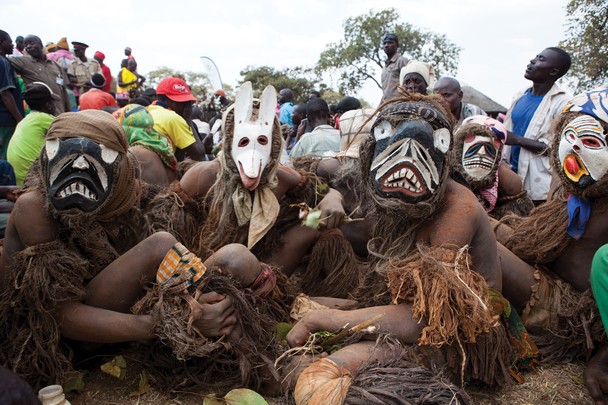Weird Cultural Practices in Africa that still exist in 2025

What are the Weird Cultural Practices in Africa that still exist in 2025? Africa is a continent of immense cultural diversity, hosting over 3,000 ethnic groups and more than 2,000 languages. Each group has its unique customs and traditions, some of which may appear unusual or even bizarre to outsiders. In this article, we will explore some of these fascinating cultural practices, delving into their historical and social contexts to understand the richness they add to the African cultural mosaic.
1. The Lip Plate Tradition
In the Mursi tribe of Ethiopia, women wear lip plates, a practice that begins with the piercing of the lower lip, which is gradually stretched to accommodate increasingly larger plates. This tradition is a rite of passage, signifying beauty and social status.
Historical Context: The origins of the lip plate are debated, but it is often seen as a way to prevent enslavement by making women less attractive to slave traders. Today, it remains a symbol of cultural identity and beauty.
2. Wooden Mask Ceremonies
In the West African countries of Mali and Ivory Coast, the Dogon and Senufo peoples hold elaborate wooden mask ceremonies. These masks represent ancestral spirits and are used in dances during funerals and harvest festivals.
Social Context: The masks are believed to bridge the spiritual and earthly realms, ensuring the community’s prosperity and harmony. The dances performed with these masks are complex, involving precise choreography passed down through generations.
3. Fattening Rooms
In Nigeria’s Efik culture, young women are sent to fattening rooms before marriage. Here, they are pampered, fed a rich diet, and taught about womanhood and marital responsibilities.
Cultural Significance: This practice is a mark of wealth and readiness for marriage. It prepares the bride both physically and mentally for her new role, emphasizing the importance of nurturing and fertility.
4. Bull Jumping
The Hamar tribe of Ethiopia practices a rite of passage known as bull jumping. Young men must leap across a series of bulls without falling to prove their readiness for adulthood and marriage.
Ritual Meaning: This ritual symbolizes a young man’s transition from boyhood to manhood. Success in this challenge is celebrated with a communal feast and marks the young man’s new status in the tribe.
5. Giraffe Women of the Ndebele
In South Africa, the Ndebele people are known for their elaborate beadwork and the practice of women wearing neck rings. These rings are added as a woman ages, elongating the neck as a sign of beauty and status.
Aesthetic Values: The neck rings are considered a symbol of wealth and beauty. They also reflect the craftsmanship and artistic expression that are integral to Ndebele culture.
6. Scarification
Scarification is a common practice among several African tribes, including the Karo of Ethiopia. These intricate patterns are carved into the skin as a rite of passage, a mark of beauty, or a sign of social status.
Symbolism: The scars are seen as a form of body art and a testament to one’s resilience and strength. They also serve as a visual representation of the individual’s life journey and tribal affiliation.
7. Stealing Each Other’s Wives – The Wodaabe Festival in Niger
In Niger, the Wodaabe tribe practices a unique and intriguing tradition that revolves around the concept of “wife-stealing,” but not in the sense one might initially think. This practice is a central feature of the annual Gerewol Festival, an event that showcases the tribe’s cultural richness and social customs.
The First Marriage: Arranged and Within the Family
In the Wodaabe community, the first marriage is traditionally arranged by the parents when the children are still young. These marriages are typically between cousins within the same family, aligning with the tribe’s customs to maintain familial ties and social order.
The Gerewol Festival: A Time for Romance and New Beginnings
The Gerewol Festival is a highly anticipated event where Wodaabe men dress in elaborate costumes, adorned with face paint and vibrant clothing designed to attract potential partners. The festival is a spectacle of beauty and courtship, featuring:
- Dancing Competitions: Men perform the Yaake dance, showcasing their physical charm and charisma to impress the women.
- Beauty Contest: The men are judged on their appearance, with emphasis on their eyes, teeth, and overall presentation.
The “Wife-Stealing” Tradition
During the festival, men have the opportunity to “steal” a new wife. If a man can successfully entice a woman and escape without being caught by her current husband or the community, the union is socially accepted. This practice is not seen as infidelity but rather as a culturally sanctioned way to form new relationships outside the constraints of the initial arranged marriages.
Social Acknowledgment and Significance
Successfully “stealing” a wife elevates a man’s social status and is a testament to his desirability and cunning. It reflects the Wodaabe’s value on individual choice and romance, providing a counterbalance to the more rigid structure of arranged marriages.
Cultural Context
The Gerewol Festival and its associated customs highlight the Wodaabe’s unique approach to marriage, beauty, and social dynamics. It is a vibrant expression of their identity, allowing personal connections to flourish in a structured yet liberating environment.
Understanding this practice offers a glimpse into the diverse and complex social customs of the Wodaabe tribe, shedding light on how cultural traditions can shape and reflect the values of a community.
Conclusion
The rich tapestry of Africa’s cultural practices is a testament to the continent’s deep historical roots and social complexity. While some of these traditions may seem odd or unconventional to outsiders, they hold profound meaning and are a source of pride and identity for the communities that practice them. Understanding these customs fosters greater appreciation and respect for Africa’s cultural heritage, illuminating the beauty and diversity of its people.




